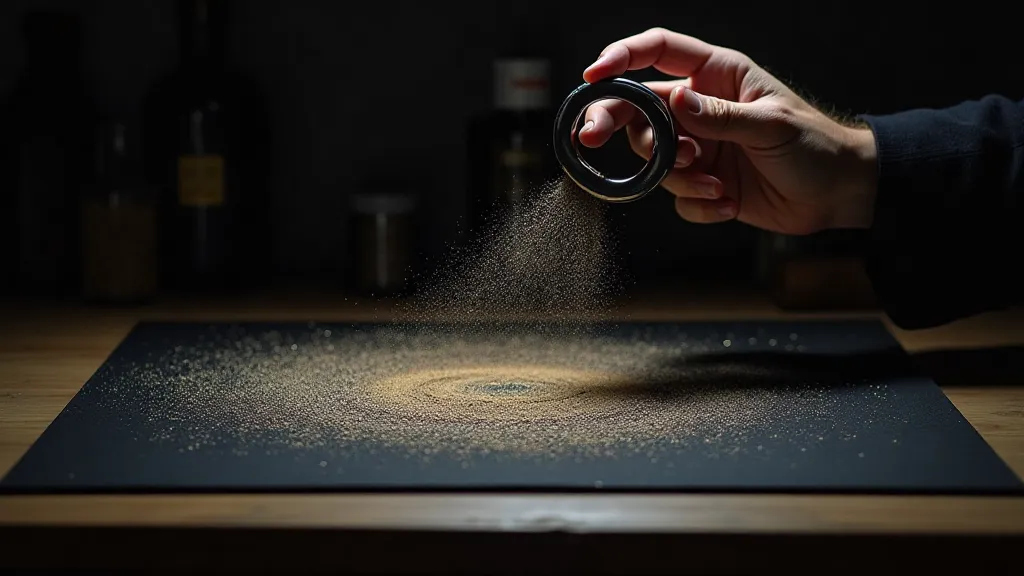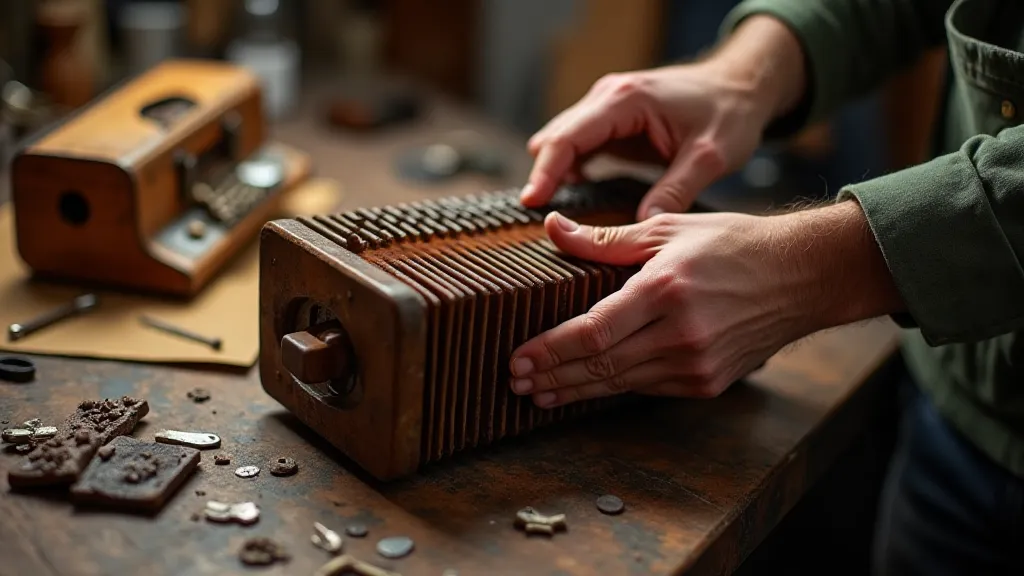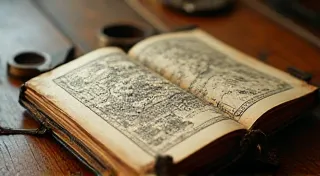The Phantom Force: Tracing Magnetic Fields with Sand and Shadow
There's a peculiar magic held within antique accordions. More than just musical instruments, they’re whispering relics of a bygone era, testaments to meticulous craftsmanship and the enduring power of human creativity. I remember finding my first one at a dusty antique shop – a Hohner Monarch from the 1930s, its bellows worn but its keys still hinting at a vibrant past. Handling it, I felt a connection not just to the music it once played, but to the hands that built it, the lungs that breathed life into it, and the hearts that found solace within its melody. It’s that same feeling of uncovering something hidden, something vital, that I find so compelling about exploring magnetic fields. Both involve perceiving an unseen force, a power that shapes our world in subtle, profound ways.
We often think of science as detached and clinical, a realm of equations and sterile labs. But at its core, science is about wonder – about relentlessly questioning and seeking to understand the universe around us. And sometimes, the most beautiful and accessible insights come not from complex machinery, but from surprisingly simple experiments that reveal the invisible.
Unveiling the Unseen: Magnetic Fields and Iron Filings
Rare earth magnets, with their exceptional strength, are a gateway to exploring these phenomena. It’s easy to feel overwhelmed when confronted with concepts like magnetic flux and magnetic permeability. But the beauty of these invisible forces can be appreciated without delving into advanced physics. One of the most captivating methods is visualizing magnetic fields using iron filings – a technique that transforms scientific inquiry into a form of art.
The principle is straightforward: iron filings are small, ferromagnetic particles that align themselves along magnetic field lines. When scattered across a surface and placed near a magnet, they reveal the shape and direction of the magnetic field with a captivating clarity. It's like watching a ghost trace its outline in the air. The resulting patterns are intricate and beautiful – swirling eddies, radial lines emanating from the poles, and graceful curves that seem to defy gravity. It's a mesmerizing display of an unseen force. The careful arrangement of these filings, the interplay of light and shadow, is almost an artistic endeavor, prompting thoughts of how early inventors might have considered harnessing such powers. Imagine the dreams they had, perhaps even contemplating something akin to visions of magnetic power driving ingenious devices – visions of magnetic power driving ingenious devices.

A History Etched in Metal: Magnetic Craftsmanship Through the Ages
The understanding and manipulation of magnetism isn’t a modern invention. Ancient civilizations, notably the Greeks, recognized the power of lodestones – naturally occurring magnets. They used them for navigation, believing they held a connection to the heavens. The early compass, a testament to human ingenuity, relied on this inherent magnetism. Think of the shipwrights, meticulously crafting compass needles, unknowingly harnessing a force that would shape exploration and trade for centuries. The precision required to create these early navigational tools speaks to a keen observational understanding of materials and their properties – a kind of practical physics passed down through generations.
The development of artificial magnets, and eventually rare earth magnets, was a gradual process, interwoven with advancements in metallurgy and electrical engineering. Each innovation built upon the previous, a chain reaction of human curiosity and relentless experimentation. The craftsmanship involved in creating even early magnets was remarkable – the precision, the attention to detail, the understanding of materials. It's a legacy that continues in the manufacture of the magnets we use today. And the responsible use of these powerful forces is paramount. It's essential to be mindful of magnet safety and responsible experimentation, ensuring that these tools are handled with care and respect for their potential.
Beyond the Science: An Artistic Lens on Magnetic Phenomena
The beauty of magnetic field visualizations extends beyond the scientific process. It’s about appreciating the elegance of natural laws, the order within chaos. It’s about finding beauty in the unseen. When you observe the swirling patterns of iron filings, you’re not just witnessing a scientific demonstration – you’re experiencing a moment of aesthetic revelation. The patterns evoke a sense of movement, of energy, of a hidden vitality.
I often find myself comparing the patterns formed by iron filings to the intricate carvings found on antique accordions. The bellows, the keys, the decorative panels – each detail is the result of countless hours of dedicated work. It's a testament to the belief that even functional objects can be beautiful, that artistry and practicality can coexist harmoniously. The accordion maker, like the scientist tracing magnetic fields, was revealing an unseen order – the mechanics of sound, the expression of emotion.
Lighting plays a crucial role in these visualizations. A single, focused light source casts dramatic shadows, highlighting the three-dimensional nature of the magnetic field. Varying the angle of the light creates an ever-changing landscape of light and shadow, transforming the static image into a dynamic, living display. It's akin to how a musician manipulates light and shade with their playing, drawing the listener into a world of emotion.

Simple Experiments, Profound Insights: A Few Ideas to Explore
The beauty of these experiments lies in their accessibility. You don’t need a fancy lab or specialized equipment. A few magnets, a handful of iron filings, a piece of cardboard, and a light source are all you need to begin your exploration. Here are a few simple experiments to get you started:
- Field Lines Around a Bar Magnet: Simply place a bar magnet under a sheet of paper and sprinkle iron filings on top. Gently tap the paper to allow the filings to settle and reveal the magnetic field lines.
- Magnetic Field Interactions: Use two magnets and observe how their fields interact – attraction, repulsion, and the formation of neutral points.
- Magnetic Field Around a Coil: Wrap wire around a core of iron and pass an electric current through it. Observe the magnetic field created.
- Shadow Play: Experiment with different lighting conditions to create dramatic shadows and highlight the three-dimensional nature of the magnetic field.
- Building a Simple Magnetic Timer: For a more advanced project, consider building a simple magnetic timer to further explore these concepts.
These experiments offer a tangible connection to the fundamental forces that shape our universe. They’d be wonderful demonstrations for children, sparking an early interest in science and engineering.
Connecting the Dots: Magnetism, Craftsmanship, and the Unseen
The exploration of magnetic fields through iron filings isn’t just a science experiment; it’s a journey into the appreciation of hidden beauty, a testament to human ingenuity, and a connection to the history of craftsmanship. It's a reminder that even the most seemingly simple objects – an antique accordion, a rare earth magnet – hold within them a story waiting to be uncovered.
The process of restoring an old accordion, like visualizing a magnetic field, requires patience, skill, and a deep respect for the original craftsmanship. Both involve revealing something that was hidden, bringing it back to life, and appreciating the beauty of its essence. It's about understanding the power of the unseen – the music that lies dormant within the bellows, the forces that shape the universe around us. Perhaps an artist, similarly inspired by these forces, might even attempt to create ephemeral sculptures - temporary constructions using magnets to demonstrate the beauty and power of attraction and repulsion.

The phantom force of magnetism, revealed through simple experiments, and the dedication of artisans creating enduring objects – these are threads that weave together a tapestry of human creativity and our relentless pursuit of understanding. Further exploration into the physics and mechanics of magnetism could lead to a greater understanding of how we perceive the world around us and the forces that shape our existence. The simple act of arranging iron filings to reveal a magnetic field pattern isn’t just a scientific demonstration; it’s a profound reflection on the beauty and order inherent in the universe.





